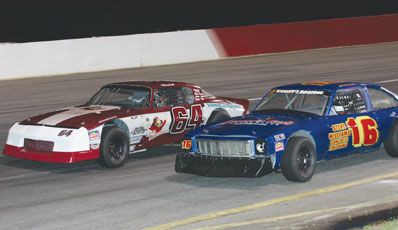
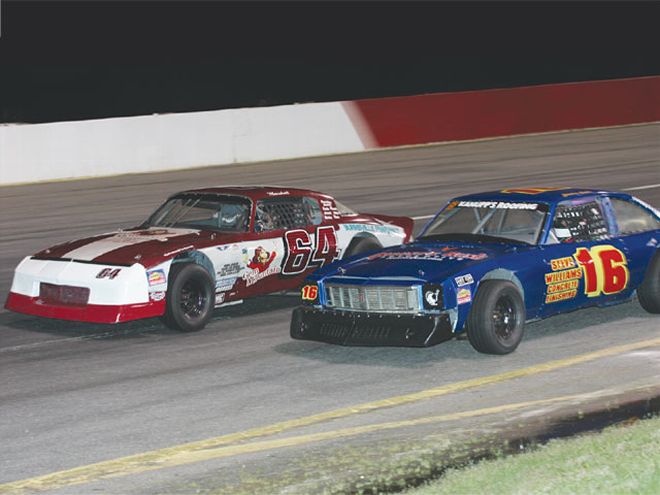
It's the last lap of your Street Stock championship race. You're driving the race of your life, passing your archenemy on the outside in a daring display of driving mastery. Suddenly, the engine goes silent. Turns out that wiring you duct taped together in the spring decides to let loose. Oops.
More often than not, wiring is one of the last things considered when building a car, and it shouldn't be. I've seen plenty of fellow racers doing wiring at the track before hot laps on opening night. But having a quality wiring job is easily within reach for the Street Stock racer, and all it takes is a little patience, some knowledge, and the following tips. We'll start at the battery and follow the path all the way to the front of the car, covering everything in-between.
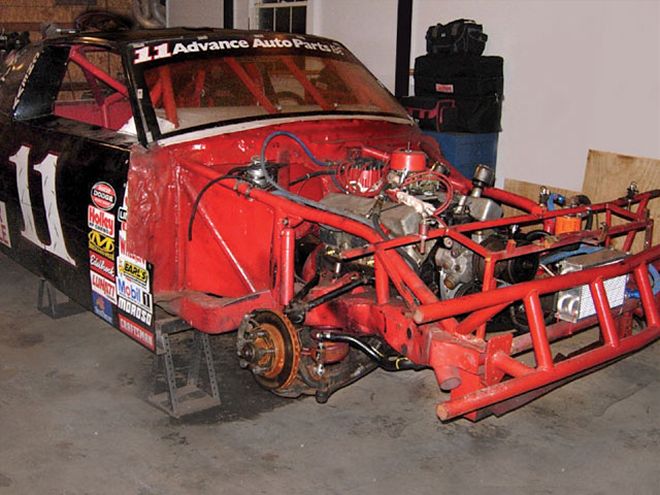 Getting ready to rewire.
Getting ready to rewire.
The battery is the fuel tank for the wiring system. It pays to use the best battery you can afford. Manufacturers such as Turbo Start have developed AGM (absorbent glass mat) technology, which provides long life and less chance for failure due to the elimination of the plates normally found in a battery. The AGM battery is sealed and poses no risk of acid leakage. Consider using a 16V battery. As Street Stock racers, we tend to use stock starters, which just can't take the heat of headers. The extra voltage of a 16V battery will eliminate the hot start problems so common in the Street Stock ranks. A 16V battery also can increase ignition firepower on HEI or other stock-type ignition systems.
You should also take the time to research some of the smaller battery companies. As battery technology moves forward, you can find some cutting-edge products that just aren't available at Wal-Mart. For example, TheV Lite Battery, an AGM battery, weighs less than 33 pounds, which is 2-3 pounds lighter than the conventional Wal-Mart special. The next step up is a full-on racing battery. Performance Distributors' DUI Dyna-Batt is a dry-cell racing battery that weighs in at a feather-like 13.5 pounds.
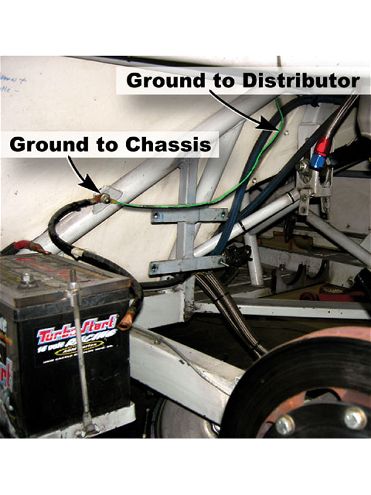 This rear mounted battery shows the main ground wire, with a secondary ground running to the front of the car.
This rear mounted battery shows the main ground wire, with a secondary ground running to the front of the car.
Electricity requires a ground in order to flow. The power side of the wiring receives all the attention, but the ground wiring is just as important. A bad ground can cause all sorts of mysterious troubles. Start by grounding the battery negative to the chassis. Mounting a stud on the chassis is an excellent idea. Be sure to clean the mounting point until it's shiny by using a wire wheel or equivalent. The stud will be your main ground point for the entire car. For rear-mounted batteries, run a 10-gauge wire from the ground stud to a convenient point near the front of the car where you can mount another stud. Attach any of your ground wires to this one.
Next, take the cap off your HEI. You'll notice that the coil is grounded. Run a wire from that ground, through the cap, and all the way to the negative post of the battery. This will ensure a properly grounded ignition system. In addition, your high-rpm efficiency can be improved by doing this. If you're using an MSD box or equivalent, you will need to use a heavy ground wire. Run this ground wire to the stud installed above.
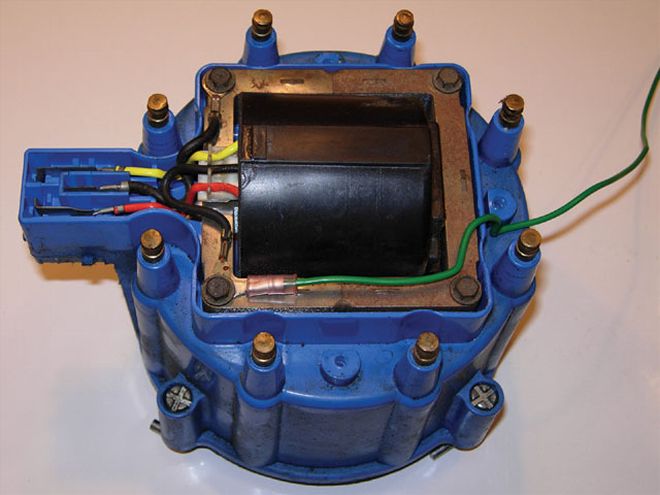 The green ground wire is run from the coil ground and then attached to a dedicated ground stud-welded to the frame or to the negative post of the battery.
The green ground wire is run from the coil ground and then attached to a dedicated ground stud-welded to the frame or to the negative post of the battery.
The main disconnect switch is an often overlooked component that can be very beneficial from both a safety and reliability standpoint. The main disconnect is used to isolate the battery from the rest of the car. Be sure to show your track's safety crew where your switch is and how the switch operates. It just may save you in the event of a crash.
When charging the battery, turn off the main disconnect to protect your valuable ignition control from voltage surges. When working around the starter, the disconnect can prevent the dreaded wrench sparking syndrome so often responsible for burn marks on your wrenches and possible damage to your ignition.
Running the alternator charging wire directly to the battery will allow the disconnect to isolate the power from the rest of the car during an emergency. The is done because, depending on where the power wire is attached, the alternator can power the car even if the battery becomes disconnected from the circuit.
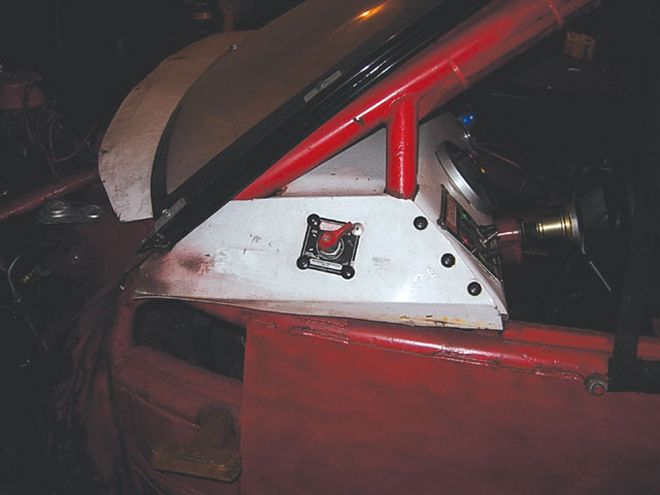 Jennerstown Street Stock driver Greg Kent is planning to move his switch from its current location to the center of the dash. Why? If the car is against the wall, emergency personnel can reach it from either side. Good idea.
Jennerstown Street Stock driver Greg Kent is planning to move his switch from its current location to the center of the dash. Why? If the car is against the wall, emergency personnel can reach it from either side. Good idea.
The main battery cable in a passenger car is hot all the time. Street Stocks usually employ a remote "Ford" solenoid to handle the starting duties. The purpose of the remote solenoid is to relocate the moving solenoid parts (usually on the starter) away from the heat source (usually the exhaust pipe or header). A secondary benefit of using a remote solenoid comes from having the wire running from the solenoid to the starter dead until the solenoid is engaged.
Hardware store terminals can be inconsistent and unreliable on a race car. Consider sourcing high-quality terminals from a dedicated wiring specialty house, such as Del City. The best terminals are made from tin-plated copper and are noticeably heavier than those found at the hardware store.
Reliability can be increased by using ring terminals, as opposed to spade-type terminals that can fall off if a screw comes loose. Terminals should be crimped with the male portion of the anvil on the solid side of the terminal. The concave portion of the crimping tool should apply force to the split side of the terminal and curl it around. This seemingly simple orientation can mean the difference between a solid crimp and one that will leave you stranded on the backstretch. Pliers, such as Channel Lock 909's, are very effective and do a much better job than the pair that came in that $3.99 wiring kit you got a few years ago for your birthday. After crimping the terminals, you can reinforce them with solder and a piece of heat shrink. The solder adds another layer of strength while the heat shrink seals the joint and provides strain relief.
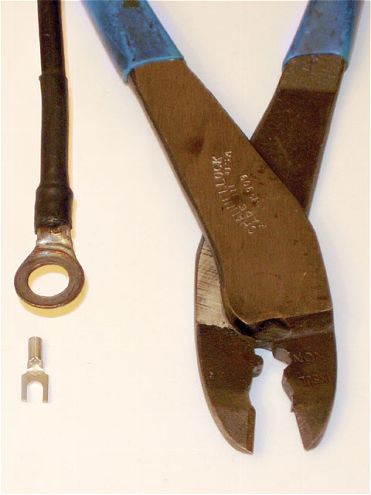 Ring terminal, spade, and 909's.
Ring terminal, spade, and 909's.
If you run on a dirt track or ever use a pressure washer to clean your race car, then you should consider Weatherpak terminals. The connectors lock positively and feature a silicone seal to keep out water and dirt, essentially providing a pressure-washer-proof wiring system. Deutsch connectors are slightly less common, but also a great option to achieve the same result. Both are available through a variety of sources. Some of these retailers, such as Batts Racing, which is run by motorcycle racer Paul Batts, also provide great technical advice on wiring.
Keep in mind that both Weatherpak and Deutsch styles require special crimping tools, but the benefits far outweigh the cost of a one-time tool purchase. Besides, when you have the tools, you can be the wiring hero of all your Street Stock friends.
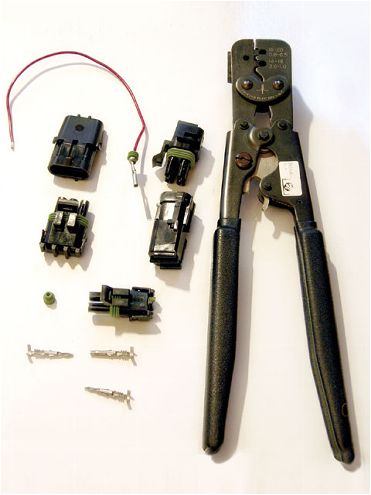 Typical Weatherpak system.
Typical Weatherpak system.
Hardware store wire is OK if you know what you're looking for. Choose wire labeled "cross-linked polyethylene" or wire marked with the SXL or TXL designation. Steer clear of unmarked wire-it may be good, but then again, it may be of inferior quality. Saving a buck or two isn't worth it, considering how much effort and money you spend on the rest of the car.
Pay attention to wire color to facilitate troubleshooting when the time comes. Some common combinations include red for power (which is hot all the time), white for switched power, and black or green for ground wires. Yellow is usually used for power to gauge lights. Companies such as Quick Car and Painless Performance sell premium copper wire, which has fine strands (for flexibility) and tough jacketing to resist abrasion, erosion from gasoline, and melting from heat exposure.
The best source I've found for switches and gauge panels is the dedicated panel-making companies such as Quick Car and Rebco. They are making panels with cool graphics, high-quality components, and useful features. These panels can also save you time when building and maintaining your car. After all, why bother with buying everything individually?
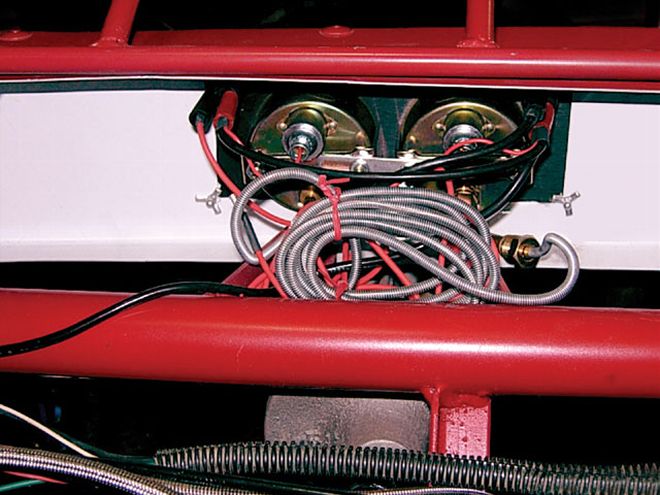 Dan Gill's Street Stock dash is ready to be wired.
Dan Gill's Street Stock dash is ready to be wired.
A good way to reduce wiring and complexity in your car is to get rid of the alternator and the associated wiring. Hold on though-before you ditch the alternator, there are a few factors to consider. Do you run long races or have a ton of cautions? Do you need to run an electric fan or blowers? If so, an alternator may be right for you. If not, you can remove it, save some horsepower, and run a few less wires.
Running without an alternator requires some advanced planning. Turbo Start's Brian Turk recommends charging your 16V battery the night before for a minimum of 12 hours to have it fully charged for the racing weekend. Deep-cycle 12V batteries may also be able to survive the evening on one charge. Consult your battery manufacturer for recommendations. A voltmeter is beneficial for obtaining a snapshot of how much power is left in the battery. On a 12V battery, look for a minimum of 13.2 volts. You can mount a voltmeter in the car or simply use a multimeter when the car comes in the pits.
If you choose to run an alternator, there are a few things to remember. Converting to a one-wire setup will reduce complexity and possibly increase reliability due to having fewer wires in the car. Run the lone wire from the battery terminal on the alternator to the battery side of the disconnect, as we discussed earlier.
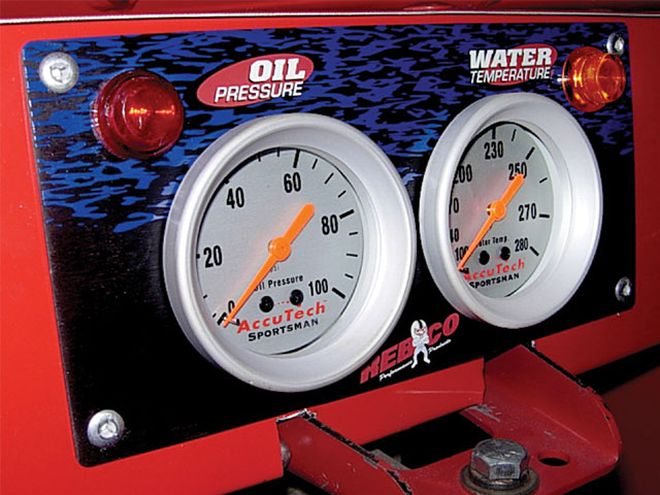 Rebco prewired panel.
Rebco prewired panel.
On the other hand, the old-fashioned three-wire alternators can provide some unique benefits. The "alt" light found on your street car can be an engine saver in the race car. If that light comes on, be sure to check your other gauges. The alternator belt usually runs via the water pump. If the light is on, your water pump may not be turning, and that can lead to a world of trouble. Some cars use a second belt to run the power steering. If you lose power steering, that's another indication you may have lost a belt. Better pull it in the pits.
Taking some time to consider your wiring as an important system of your race car can prevent headaches later. By selecting the proper high-quality components and installing them carefully, you can create a bulletproof wiring system that will serve you well for many races to come.
Brian Turk from Turbo Start offers this suggestion. If using a traditional plate-type battery, pay special attention to the way the battery is mounted in the battery box. On an oval track car, run the battery so the plates are facing side to side. In other words, the plates should run 90 degrees (perpendicular) to the main framerails. Most of the g-forces, which could damage the battery, are encountered during cornering. This orientation gives maximum protection against plate shifting, which can lead to battery failure.
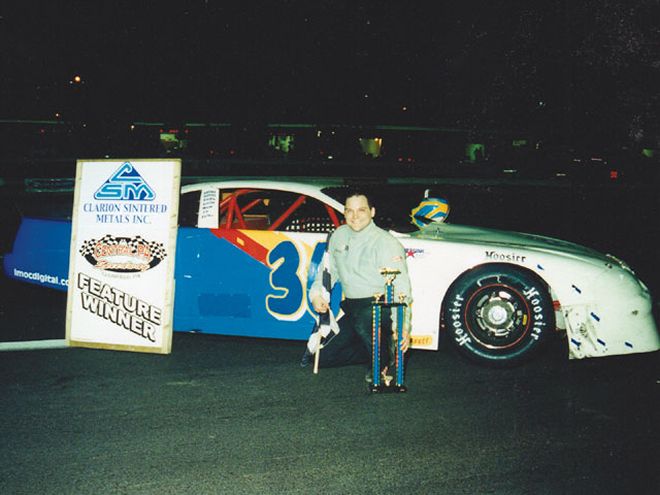
Ramey Wormer grew up tinkering in his dad's garage. He spent many an hour thumbing through photos of his father's No. 36 racer wondering what it would be like to get behind the wheel. After graduating from Penn State University with a mechanical engineering degree, Wormer built a Pure Stock to race at the Clearfield Speedway. Some driving success and a thirst for knowledge led him to learn everything he could about what makes a car tick. Wormer excelled at Clearfield, collecting the 1995 Pure Stock Championship and later the 2000 Late Model Sportsman Championship.
While racing, he developed a knack for writing about his experiences as well as racing technology. His work has been published in local and national racing publications. Even so, Ramey says that his biggest accomplishment is winning 14 features with home-built cars and engines while on a shoestring budget. A season spent as a crew chief on a USAR Hooters team introduced him to the world of professional short track racing, where he currently works as a spotter for Aaron Will in the Hooters Pro Cup North Division.
When he is not writing, Ramey enjoys motorcycling and working on his Troyer dirt Modified. He lives in central Pennsylvania with his wife Carole and infant son, lead-footed future kart hotshoe, Sammy.